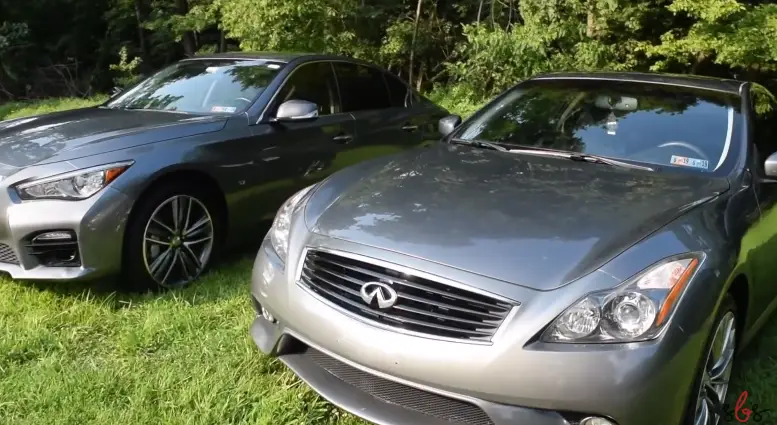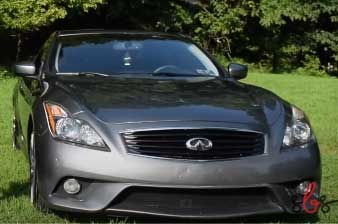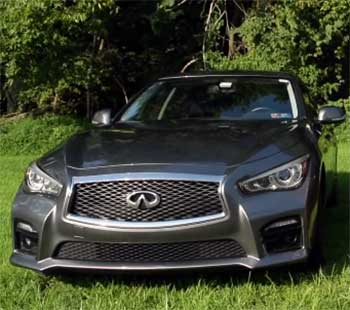You’re in the market for a sporty luxury sedan, and Infiniti’s G37 and Q50 are on your radar. Both cars promise thrilling performance and upscale interiors, but which one suits you best? I’ve driven both, dissected their specs, and weighed their quirks to bring you a clear comparison. This article breaks down the pros, cons, and key features of the Infiniti G37 and Q50, helping you make an informed choice. Whether you crave raw driving excitement or modern tech, let’s explore what these sedans offer.

Comparison Table of Infiniti G37 vs. Infiniti Q50
| Feature | Infiniti G37 (2008-2013) | Infiniti Q50 (2014-present) |
| Base Engine | 3.7L V6, 328-330 hp | 3.0L Twin-Turbo V6, 300 hp |
| Fuel Economy (MPG) | 20 combined (17 city/25 highway) | 23 combined (20 city/29 highway) |
| Starting Price (Used) | $6,130-$17,997 (2008-2013 models) | $35,980-$48,569 (2024 models) |
| Transmission | 7-speed automatic, 6-speed manual (select) | 7-speed automatic |
| Drivetrain | RWD, AWD available | RWD, AWD available |
| 0-60 MPH | 5.3-5.6 seconds | 5.0-5.3 seconds (3.0T), 4.5 (Red Sport) |
| Interior Volume | 99 cu. ft. (sedan) | 104 cu. ft. (sedan) |
| Cargo Space | 13.5 cu. ft. (sedan) | 13.5 cu. ft. (sedan) |
| Steering | Hydraulic | Electronic (Direct Adaptive Steering) |
| Infotainment | Analog clock, basic nav | Dual LCD screens, advanced tech |
My Journey with the Infiniti G37
When I first slid into the driver’s seat of a 2011 Infiniti G37x Coupe, the growl of its 3.7-liter V6 sent a shiver down my spine. This car was built for enthusiasts like me, with a naturally aspirated engine pumping out 330 horsepower in the coupe and 328 in the sedan. The throttle response was razor-sharp, especially in the Sport models, which paired with a 6-speed manual in some trims—a rare treat for purists.
I remember flooring it on an open highway, the V6 roaring as the car surged to 60 mph in about 5.3 seconds. The hydraulic steering felt alive, offering feedback that made every turn a conversation between driver and machine. The G37’s exterior design still turns heads. Its sleek, low-slung profile and aggressive stance scream performance.

I drove a 2013 G37 Sedan with the Journey trim, and its 18-inch wheels and subtle chrome accents gave it a timeless look. Inside, the cabin was cozy—some might say cramped—but it felt like a cockpit built for driving.
The leather seats were supportive, though the lack of thigh bolstering was noticeable during spirited cornering.
The analog Infiniti clock on the dash added a touch of class, but the infotainment system, with its small screen and clunky interface, felt dated even back then.
I took the G37 on a weekend trip through winding backroads, and its front-midship (FM) platform shone. The chassis was stiff, and the rear-wheel-drive setup (AWD was optional) delivered balanced handling. The 7-speed automatic shifted smoothly, though I missed the manual’s engagement. Fuel economy wasn’t its strength—averaging 20 mpg combined—but the trade-off was worth it for the power.
Maintenance was straightforward, thanks to the naturally aspirated V6’s simplicity, but premium gas was a must. Some owners I spoke with grumbled about oil consumption issues in early models. One gripe? The 15-spoke wheels on some G37s looked busy and dated.
I met a guy at a car meet who swapped his out for cleaner 19-inch rays, and it transformed the car’s vibe. Reliability was solid overall, though 2007-2008 models had some electrical gremlins. By 2011, most kinks were ironed out, making those later years a safer bet.
Pros of the Infiniti G37
- Thrilling Performance: The 3.7L V6 delivers 328-330 horsepower with instant throttle response, perfect for enthusiasts.
- Engaging Handling: Hydraulic steering and a stiff FM chassis make it a driver’s car, especially in Sport trims.
- Manual Option: A 6-speed manual was available on select models, a rarity in the luxury segment.
- Affordable Used: Prices for 2008-2013 models range from $6,130 to $17,997, offering great value.
- Timeless Design: Sleek lines and aggressive styling still look sharp today.
- Reliable Engine: The naturally aspirated V6 is durable with proper maintenance, avoiding turbo complexity.
Cons of the Infiniti G37
- Dated Infotainment: The system feels clunky, with a small screen and slow response.
- Fuel Economy: 20 mpg combined is thirsty compared to newer rivals.
- Tight Interior: 99 cu. ft. of passenger space feels snug, especially in the coupe.
- Premium Gas: Requires high-octane fuel, increasing running costs.
- Early Model Issues: 2007-2008 models had electrical and oil consumption problems.
- Limited Tuning Potential: Naturally aspirated engine limits aftermarket power gains compared to turbocharged rivals.
My Experience with the Infiniti Q50
Fast forward to a 2018 Q50 Red Sport 400 loaner I drove for a week while my friend’s car was in the shop. The Q50 felt like the G37’s more refined sibling. Its 3.0-liter twin-turbo V6 churned out 300 horsepower in base trims, but the Red Sport’s 400 horsepower was a revelation. I hit 60 mph in about 4.5 seconds, the turbos spooling with a surge that felt different from the G37’s linear pull.

The 7-speed automatic was crisp, though I longed for a manual option—sadly, not offered. The Q50’s exterior is bolder, with a pronounced double-arch grille and sculpted lines inspired by Infiniti’s Essence concept.
I parked next to a G37 at a coffee shop, and the Q50’s wider stance and sharper creases stood out.
The interior was a step up, with 104 cu. ft. of space and dual LCD screens—one 8-inch for navigation, another 7-inch for audio and apps.
The aluminum trim and available leather felt premium, though the seats were softer than I’d like for aggressive driving.
The tech was a mixed bag: the infotainment was more modern but laggy, and the backup camera took ages to boot up.
On the road, the Q50’s Direct Adaptive Steering (electronic, not hydraulic) felt numb compared to the G37. I drove a 2019 Q50 3.0t AWD through a rainstorm, and the lighter steering was great at low speeds but lacked soul on twisty roads.
The AWD gripped well, but RWD models with the open differential could get squirrelly in wet conditions—one owner I met nearly spun out at 60 mph. Fuel economy was better at 23 mpg combined, and the 580-mile highway range beat the G37’s 480 miles.
However, the twin-turbo setup meant more complex maintenance, with cooling hoses and three radiator caps cluttering the engine bay. The Q50’s tech, like lane departure warnings and adaptive cruise, felt futuristic but overwhelming.
I fumbled with the dual screens to adjust settings, missing the G37’s simplicity. Some early Q50s (2014-2015) kept the G37’s 3.7L V6, blending old-school power with newer styling. Tuning potential was a highlight—a friend boosted his Q50 from 300 to 450 horsepower with $2,600 in mods, something the G37’s naturally aspirated engine couldn’t match.
Pros of the Infiniti Q50
- Potent Powertrains: 300-400 horsepower options, with the Red Sport 400 hitting 0-60 in 4.5 seconds.
- Better Fuel Economy: 23 mpg combined and 580-mile highway range outperform the G37.
- Spacious Interior: 104 cu. ft. of passenger space feels roomier than the G37.
- Modern Tech: Dual LCD screens, navigation, and driver aids like adaptive cruise add convenience.
- Tuning Potential: Twin-turbo V6 responds well to mods, offering big power gains.
- Refined Styling: Aggressive grille and sleek lines give it a bold, modern look.
Cons of the Infiniti Q50
- Numb Steering: Electronic steering lacks the G37’s tactile feedback.
- Complex Maintenance: Twin-turbo V6 and extra cooling systems increase repair costs.
- Laggy Infotainment: Slow boot-up and clunky interface frustrate daily use.
- No Manual Option: Automatic-only transmission disappoints enthusiasts.
- Open Differential Issues: RWD models can lose traction in wet conditions.
- Higher Price: Used 2024 models range from $35,980 to $48,569, pricier than G37s.
Performance and Driving Dynamics
The G37 and Q50 are built on Infiniti’s FM platform, a stiff, balanced chassis that’s a joy to push hard. I took a 2012 G37 Sport through a mountain pass, and its hydraulic steering telegraphed every road nuance, making me feel one with the car. The 328-horsepower V6 delivered power instantly, with no turbo lag. The 6-speed manual (available on Sport models) let me row gears with precision, though the clutch was heavier than I expected.
The Q50, by contrast, felt more isolated. I drove a 2016 Q50S AWD on similar roads, and the electronic steering, while light and easy in traffic, felt detached at speed. The 3.0-liter twin-turbo V6 in the Red Sport trim was a beast, but the power came in surges, not the G37’s smooth rush.
The Q50’s 7-speed automatic shifted quickly, but I missed the manual’s engagement. The Q50’s optional Dynamic Digital Suspension balanced comfort and sportiness better than the G37’s stiffer setup, especially on long drives.
In wet conditions, the G37’s R200 differential and higher gear ratio gave it better low-end grip. The Q50’s R190 differential, especially in RWD models, could lead to wheel spin—one owner I met described a scary slide in the rain. Both cars offer AWD, but the Q50’s system felt more polished, likely due to software tweaks.
Interior and Comfort
The G37’s interior is driver-focused but tight. I spent a day in a 2013 G37x Sedan, and the front seats were comfy, but rear passengers felt cramped with less leg and shoulder room. The 13.5 cu. ft. trunk was adequate for groceries but struggled with larger items. The analog clock and leather trim added charm, but the infotainment screen was small, and navigation felt like an afterthought.
The Q50’s cabin is noticeably roomier, with more front and rear legroom. I drove a 2017 Q50 Hybrid with perforated leather and loved the extra space, though the soft seats didn’t hug me during hard cornering.
The dual LCD screens were a tech upgrade, but the interface lagged, and climate controls were awkwardly placed. The trunk matches the G37’s 13.5 cu. ft., but the sedan’s wider opening made loading easier. The Q50’s Japanese Ash accents and optional BOSE audio added luxury, though I found the voice recognition spotty.
Read More: Acura Integra vs. Honda Accord
Technology and Features
The G37’s tech feels like a time capsule. Its basic navigation and analog gauges were functional but outdated even in 2013. I remember fumbling with the clunky menus during a road trip, wishing for a smartphone integration that wasn’t standard. Backup cameras and parking sensors were available, but not as seamless as modern systems.
The Q50 leaps forward with dual touchscreens, real-time navigation, and driver aids like blind-spot monitoring. I tested a 2019 Q50 Red Sport, and features like adaptive cruise were handy on highways, though the system felt intrusive in traffic. The infotainment’s slow boot-up was a constant annoyance, and the lack of Apple CarPlay in early models stung. Later Q50s (2020+) added smartphone integration, closing the gap with rivals like the BMW 3 Series.
Reliability and Maintenance
The G37’s naturally aspirated V6 is a workhorse. I spoke with a mechanic who praised its longevity, though early 2007-2008 models had electrical issues and oil consumption quirks. By 2011, most problems were resolved, and my friend’s 2012 G37x ran flawlessly past 100,000 miles with regular maintenance.
The Q50’s twin-turbo V6 is reliable when stock, but its complexity—cooling hoses, intercoolers, and extra sensors—raises repair costs. A forum user I connected with had no issues at 40,000 miles on a 2018 Red Sport, but modded Q50s pushing high boost risked turbo failure. Early Q50s (2014-2015) with the 3.7L V6 offered a simpler alternative, blending G37 reliability with Q50 styling.
Pricing and Value
I scoured used car listings, and the G37 is a bargain. A 2008-2013 G37 ranges from $6,130 to $17,997, depending on condition and mileage. I found a 2013 G37x Sedan with 72,000 miles for $14,000—a steal for its performance. The G37’s lower price and simpler mechanics make it a value champ for enthusiasts on a budget.
The Q50 commands a premium, with 2024 models priced between $35,980 and $48,569 used. A 2018 Q50 3.0t I checked out was listed at $28,000 with 50,000 miles. The higher cost reflects newer tech and styling, but you’re paying for complexity. Early Q50s with the 3.7L V6 (2014-2015) offer a middle ground, often found for $20,000-$25,000.
Tuning and Modification Potential
The G37’s naturally aspirated V6 is smooth but lacks tuning potential. I met a tuner who added a cold air intake and exhaust to his 2011 G37x Coupe, gaining maybe 20 horsepower. The VQ37VHR engine hits a ceiling quickly without forced induction, which is costly and rare.
The Q50’s twin-turbo V6 is a modder’s dream. A friend in a car group boosted his 2017 Q50 from 300 to 450 horsepower with $2,600 in upgrades—intake, tune, and exhaust. The Red Sport 400 pushes even higher with minimal work. However, pushing turbos too hard risks reliability, and stock Q50s already feel quick.
Which One Should You Choose?
You’re probably wondering which car I’d pick. The G37 is my heart’s choice for its raw, unfiltered driving feel. Its hydraulic steering and linear V6 power are addicting, and the used market makes it a steal. But the Q50 wins for daily usability—better fuel economy, roomier cabin, and modern tech make it a practical luxury sedan.
If you’re an enthusiast on a budget, hunt for a 2011-2013 G37 Sport with a manual. If you want power and refinement, a 2018+ Q50 Red Sport 400 is hard to beat, provided you’re okay with pricier maintenance. Both cars share Infiniti’s FM platform, so neither disappoints dynamically.
I lean toward the G37 for its purist soul, but the Q50’s tech and tuning potential are tempting. Test drive both, feel the steering, and listen to the engine’s song—your gut will guide you.
Frequently Asked Questions (FAQ)
It depends. The G37 offers raw driving feel and lower cost, ideal for enthusiasts. The Q50 has better tech, fuel economy, and tuning potential but feels less engaging.
Yes, the Q50 Red Sport 400, with 400 horsepower and a 4.5-second 0-60 time, is Infiniti’s fastest sedan.
Avoid 2007-2008 models due to electrical issues and oil consumption problems. 2011-2013 are more reliable.
Yes, the Q50 replaced the G37 Sedan in 2014, but Infiniti sold the G37 alongside it until 2015 as a budget option.
Conclusion
As I reflect on my time with the Infiniti G37 Sedan and Q50, I’m torn. The G37’s raw, driver-focused spirit won me over with its simplicity and value, but the Q50’s modern flair and comfort are hard to ignore. For you, the choice hinges on what you value most: a budget-friendly, engaging ride or a tech-laden, refined cruiser.
Test drive both, feel the steering, and listen to the engine’s roar. Whichever you pick, Infiniti’s blend of luxury and performance won’t disappoint.

